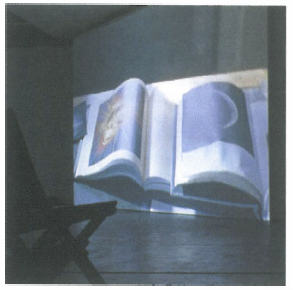
A Fine Line is a new video installation by Dublin artist Grace Weir in a one-time collaboration with scientist Ian Elliot. The installation consists of five video pieces in all, three large wall projections Deja vu, The Darkness and the light and Dust defying gravity counter-posed with two smaller monitor pieces Bending space-time in the basement and Paper exercises. The projections are cinematic and poetic allegories whilst the monitor pieces are more 'objective' documentations that are said to serve as footnotes (see catalogue). The logic of this was sound and helped weave the work together coherently.
Huddled into a far corner of the EAF, Bending space-time in the basement presents an experiment demonstrating the effects of mass and gravity in space-time. In the essay accompanying the exhibition, Francis McKee begins with an excerpt taken from the work highlighting a moment of subtle transformation. Weir asks 'If our point of equilibrium shifts something has changed&?' to which Ian Elliot replies, 'Oh yes'. The emphasis on 'our' and not 'a' points toward the personal, and thus, it is a compelling and revelatory study of subtle transformations, both personal and scientific.
Paper exercises involved explaining the theory of relativity using simple hand-drawn diagrams. Elliot and Weir are again engaged in the dynamics of understanding through the objectives of science. On this occasion looped video (necessary in a gallery context but annoying) felt entirely appropriate. I sat through three loops and began to understand the propositions presented. Perhaps I too was undergoing a shift.
Weir deploys cinematic tropes and devices in all three projected works to reflect on the science being investigated. From the conscious choice to use film to the use of editing and narrative, she attempts to parallel the science demonstrated in the accompanying footnotes.
Unlike the masses of lead used to 'bend' space-time Dust defying gravity poetically offsets the heavy objectivity of its footnote counterpart. Using long tracking (one continuous shot) Weir's lens journeys through an anonymous room (evocative of a scholar's study during the Enlightenment), tracing over various instruments that measure space and time, eventually capturing flecks of dust flickering through a stream of light over brass planetary spheres. The effect is dream-like.
Déjà vu could be considered the most ambitious 'cinematic' work in the show and again serves as poetic relief to Paper exercises. Constructed narrative, slow motion and editing are employed reflexively to convey the ideas of relativity. A minor event links two characters together at a relative point in time, however, their gaze never meets and (perhaps) the crucial moment is missed. For me, it evokes Hans Holbein's The Ambassadors in that it disturbs the idea of single point perspective.
The Darkness and the light featuring Ian Elliot is a meditation on super-string theory. The props used to explain difficult theory are again simple. This time an A4 sheet of paper is cut into half then quarters, eighths, sixteenths and so on, 'Ten cuts equals a thousandth, thirty one cuts, a billionth' (Elliot). With the aid of a powerful lens the sheet could quite conceivably be divided into infinite subatomic particles. As if to demonstrate this, Elliot directs a concentrated beam of refracted light from telescope to paper burning it up, matter destroying matter.
This is the stuff that Weir meditates on and presents; light, energy, matter, weight, force, gravity, movement – in which the viewer can draw open and interesting parallels – no matter what the position or means of discovery and in this sense A Fine Line reminds us of this capacity, beautifully.












